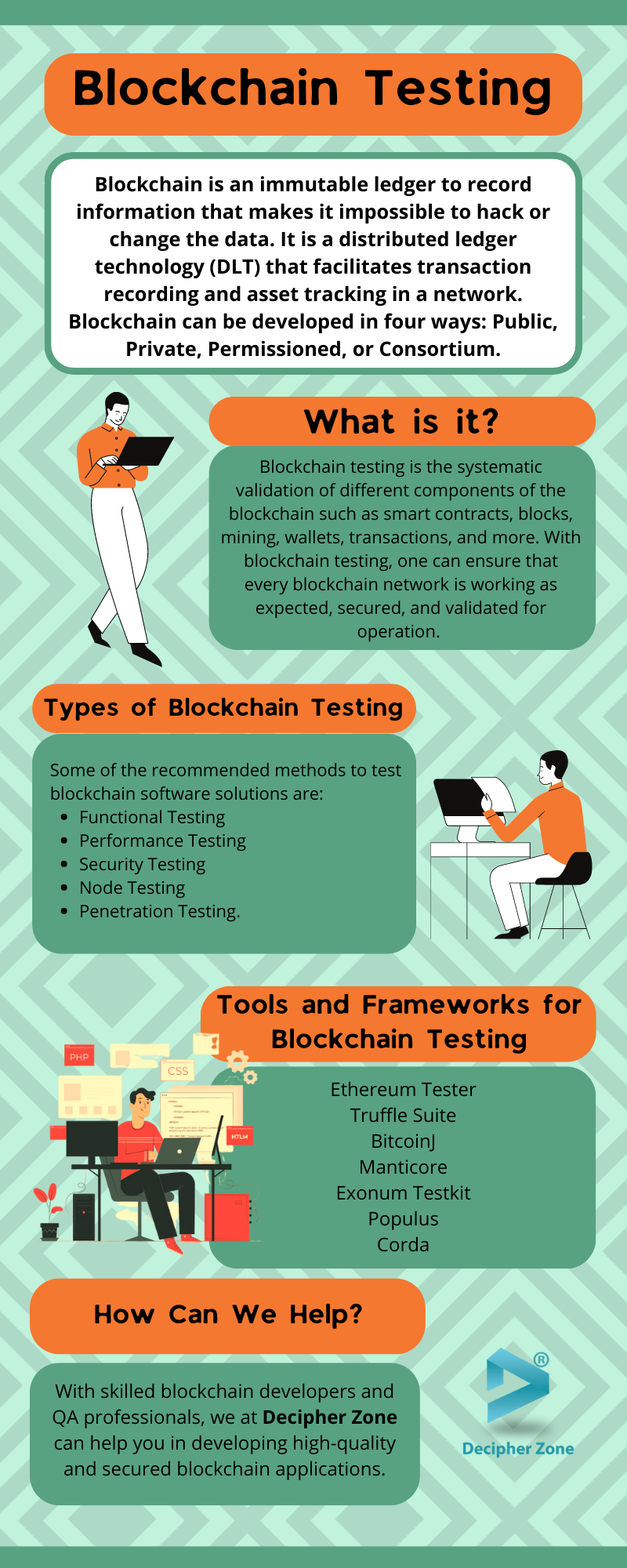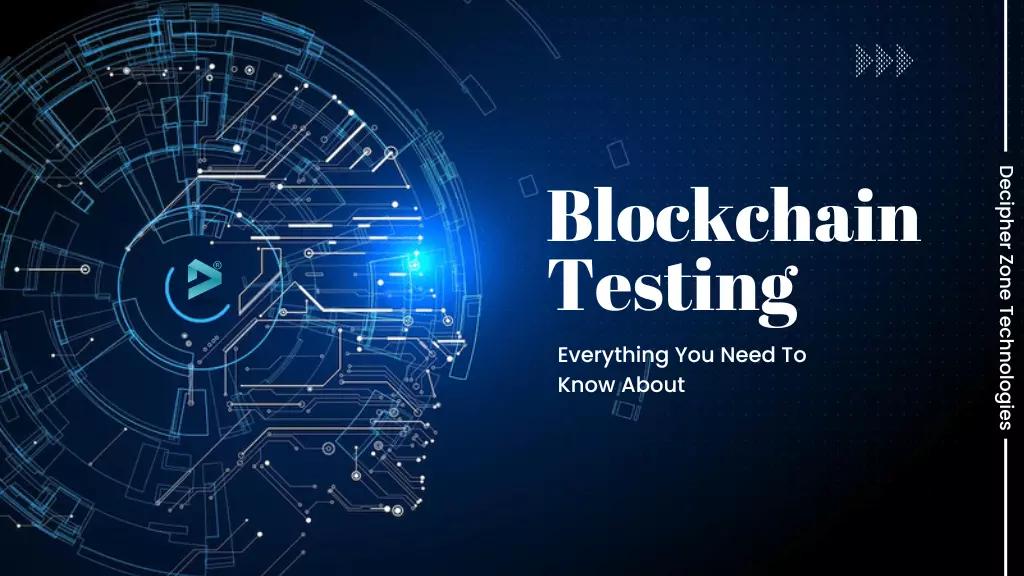Blockchain technology continues to evolve with no sign of decelerating. Besides, the number of businesses using blockchain’s cryptography technology for data transactions has taken the world by storm. Unsurprisingly, global spending on blockchain-based solutions is forecasted to reach roughly $19 billion by 2024.
But do we understand what blockchain is, how it works, or the challenges one faces in testing a blockchain.
We will discuss everything you need to know about blockchain testing, whether it's the challenges, types of testing, testing process, or best practices.
Without further ado, let’s get started!
What is Blockchain?
Blockchain is an immutable ledger to record information that makes it impossible to hack or change the data. It is a distributed ledger technology (DLT) that facilitates transaction recording and asset tracking in a network.
Read: What is Blockchain Technology & How Does it Work
Blockchain consists of records or blocks interconnected through cryptography. Each record includes a cryptographic hash along with the timestamp and transaction data of the previous block. As every block has data from the last block, they create a chain of blocks and make transactions irreversible.
Read: Consensus Algorithms in Blockchain
Blockchain can be developed in four ways: Public, Private, Permissioned, or Consortium.
-
Public Blockchain Network: Anyone can join and engage in the public blockchain network, i.e., they can read, write, and edit ongoing activities, making it decentralized and self-governed in nature. However, there is little to no transaction privacy and weak security in the public blockchain that you need to consider before considering this for your business.
-
Private Blockchain Network: It is also a decentralized network that is governed by one organization, controlling the participation, execution, and maintenance of the blockchain. You can either host it on-premises or behind a firewall.
-
Permissioned Blockchain Network: It is a hybrid of public and private blockchain networks as it allows anyone to access the network as long as they went through an identity verification process.
-
Consortium Blockchain: It is a private group of blockchains where each blockchain is administered by individual organizations that come together to share information for better transparency, accountability, and workflows.
As blockchain technology is relatively new in the market, it suffers from a lack of testing methodology standardization and processes.
What is Blockchain Testing?
While the unique features of blockchain have made it popular in different industries, they also contribute to its complexity. Thus, it becomes important to test and validate the blockchain system before deploying them in the production environment.
Read: How will 5G change the behavior of Blockchain Technology
Blockchain testing is the systematic validation of different components of the blockchain such as smart contracts, blocks, mining, wallets, transactions, and more. With blockchain testing, one can ensure that every blockchain network is working as expected, secured, and validated for operation. The core aim of testing blockchain is to ensure full test coverage so that a quality blockchain solution can be developed.
Read: Use Cases for Blockchain: Top 5 Real-Life Usage
But blockchain brings extreme challenges in the testing world. Some of the top challenges one might face during testing include -
-
Understanding blockchain technology and defining test strategies
-
Lack of standardized blockchain testing tools and best practices
-
Validating and verifying each block getting recorded to the blockchain network for every transaction.
-
Maintaining block and chain size.
-
Failure risks in sharing crypto-graphical data.
Types of Testing in Blockchain
Some of the recommended methods to test blockchain software solutions are Functional Testing, Performance Testing, Security Testing, Node Testing, and Penetration Testing.
Read: How to Build a Blockchain In Rust
Let's take a look at what they mean now.
-
Functional Testing: It is conducted to evaluate the blockchain solution compliance with specific feature requirements as it often describes what the system does. Functional testing is a part of black-box testing, i.e., it only examines the application functionality without looking into its internal workings or structures. So, the QA doesn’t have to know the programming language used or how the component of the blockchain system has been implemented to perform functional tests. Integration testing, unit testing, smoke testing, and regression testing are some examples of functional testing.
-
Performance Testing: It ensures that the blockchain application is working accurately under expected conditions and workloads. Performance testing evaluates the quality and capability of the blockchain solution in terms of scalability, speed, stability, and reliability under changing conditions. It aims to remove performance bottlenecks and identifies areas of improvement while making the blockchain solution fast, stable, and reliable.
-
Security Testing: It detects and identifies security vulnerabilities in the blockchain system’s network, client-side, or server-side. It aims to protect the system from possible intruders by ensuring that there are no possible loopholes, risks, threats, or vulnerabilities in the system. Confidentiality, Authenticity, Authority, Integrity, Availability, and Non-Repudiation are the core principles followed in security testing. Simply put, it is used to debug the system, allowing blockchain solutions to perform highly secured transactions.
-
Node Testing: Every diverted node available on the network should be tested independently for accurate recording and a risk-free connection.
-
Penetration Testing: It is a modeled cyber attack on one’s blockchain system that helps in recognizing any exploitable vulnerabilities. Penetration testing consists of attempted breaches on servers, APIs, etc. to discover weaknesses prone to injection attacks on the code.

Understanding Tools and Frameworks for Blockchain Testing
Now that we know the types of testing blockchain, it’s time to move ahead with some popularly used Blockchain testing frameworks and tools.
Read: Latest Trends in Blockchain Technology
-
Ethereum Tester: eth-tester is a tool for Ethereum-based dApps that provides a high abstraction level to perform tests. It strictly enforces different input types and formats as follows:
-
It is not necessary to use the 0x prefix in the hexadecimal value, but it is a must to make the hexadecimal values - text strings not byte.
-
It is crucial to encode 32-byte hashes into hexadecimal values.
-
As described by EIP-55, any address containing mixed-case alpha characters must be validated as a checksummed address.
-
Each numeric value in the network should be represented in integer format.
-
Using Ethereum tester, developers can replicate production like the Ethereum blockchain by integrating APIs, Smart Contracts, and Web3.
-
Truffle Suite: It is one of the comprehensive suites for compiling, testing, debugging, and deploying blockchain systems. Truffle suit includes different tools namely Ganache, Drizzle, Truffle, and Truffle for VSCode that make the development of smart contracts easier and more manageable.
-
BitcoinJ: It is a Bitcoin library that offers full verification mode, lightweight simplified payment verification mode, wallet class, micropayment channels, and asynchronous and thread-per-connection. Using BitcoinJ, developers can easily develop secured and reliable contract-based crypto wallet applications.
-
Manticore: A symbolic execution tool that offers multiple features like program exploration, input generation, error detection, programmatic interface, and instrumentation for smart contracts, modules, and binaries analysis.
-
Exonum Testkit: It is used to test blockchain application activity. Exonum Testkit helps in testing service APIs as well as execution of transactions in the synchronous method without fretting about consensus algorithm and network operation.
-
Populus: It is an Ethereum framework that acts as a well-integrated set of properties used for smart contracts testing and development.
-
Corda: An distributed, open-source ledger platform used to build decentralized apps on a secured, private, and scalable platform. It is a peer-to-peer, scalable platform that allows developers to build an application that can create trust between stakeholders in the marketplace. Some of the features it comes with include asset fluidity, single identity with mutual membership, interoperability, and secured transactions. It also consists of built-in tools for integration testing, contract testing, load testing, and flow testing in the blockchain application.

Conclusion
Blockchain technology is the future of the financial industry, making it essential to deliver high-quality and secure products. Needless to say, blockchain testing ensures that the components and functionalities in the systems work as expected. It also helps to build an application where members can interact and transact in a secure and trustworthy manner.
If you too are a business owner who wants to invest in blockchain-based fintech applications, then hire developers with years of expertise and experience from top blockchain development companies like Decipher Zone.
Read: Best Practices for Unit Testing in Java
But first, get in touch with our team to share your idea and receive a customized and cost-effective quote for blockchain app development.

